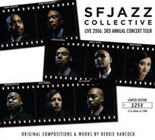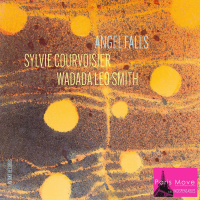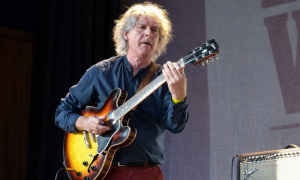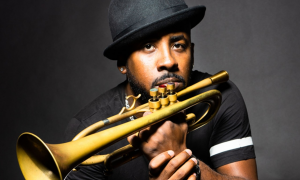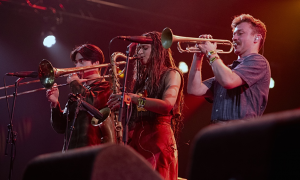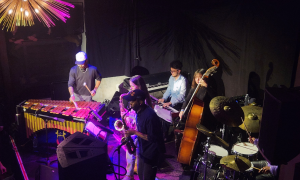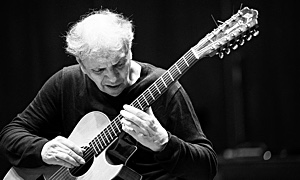Home » Jazz Articles » Live Review » Portland Jazz Festival Day 2: February 17, 2007
Portland Jazz Festival Day 2: February 17, 2007
Day two of the Portland Jazz Festival (PDX Jazz) was a bit of a rarity, with the sun burning away a thick layer of early morning fog, and temperatures rising to the mid-60s. But the majority of the heat was generated indoors, with a number of outstanding performances, and the continuation of the ECM Jazz Roundtable.
Chapter Index
- ECM Roundtable: Cover Art
- Jazz Dialogue: Charles Lloyd
- Diego Ramirez
- Geri Allen Trio
- Trygve Seim
- Don Byron
- Dave Douglas Quintet
- Jazz Dialogue: Charles Lloyd
ECM Roundtable: Cover Art
The subject for the day's ECM Roundtable was cover art. In addition to ECM's Steve Lake and Tina Pelikan, writers Josef Woodard and Neil Tesser and writer/moderator Howard Mandel, the panel also included Dorothy Darr (wife of Charles Lloyd, co-producer of the woodwind multi-instrumentalist's releases since 2000's The Water is Wide, and overseer of cover art and graphics) as well as Portland resident Dave Anolik, Vice President and Creative Director of Quango Design and Marketing.
Anolik kicked off the roundtable with a remarkable presentation that brought together almost all of ECM's nearly 1000 covers, grouping them into various themes (eg. triangle, water, sky, typography). Most striking was the revelation that these themes often spanned many years and were not linked closely together. This apparent disunity brought the discussion back to the auteur issue—whether there was a specific plan with respect to these various themes or whether it was a more organic process, something that emerged more out of the label (and, specifically, Eicher's) aesthetic.
Another interesting point regarding cover design came via Gary Burton, who had shed some light on the subject during a dinner on Thursday evening with some of the participants. In the early days, partly as a cost-saving effort, Eicher would have books of artwork and, rather than commissioning an artist or photographer to create something to be used, the artists would have the opportunity to go through the collection of pieces and "reserve" one for their next release. Burton explained how there was a distinct advantage to this, as it was possible to see something that linked in some way to the music, rather than hoping a commissioned artist would get it right.
The fact that, unlike most classical recordings, the ECM New (or composed) Series releases rarely have liner notes and, if they do, rarely address the music directly, came up as an omission that also differentiates the regular (or improvised) series from other labels. Eicher believes the music should speak for itself and that there are plenty of places to seek informative background, enabling the label to shift its focus from words to more aesthetic matters.
There was some discussion about the changing landscape of music delivery—from the vinyl days, where album covers were 12"x12" to the CD which, despite the reduced scale of covers, offers expanded opportunities for imparting information or integrating creative visuals through booklets. However, the next prospect—offering music in downloadable form—was seen as a threat, potentially eliminating artwork altogether.
For a label that views its musical releases as complete packages integrating music with visual art, this is a significant and potentially distressing development, as is the idea of selling single songs off CDs on which much effort has gone into programming—the sequencing of the material so that the entire disc has a defined narrative arc. Still, over the course of 38 years ECM has stuck to its aesthetic, choosing not to bow to the pressures of marketplace trends, and ultimately been the stronger for it.
Jazz Dialogue: Charles Lloyd
Following the roundtable discussion the audience was treated to a jazz dialogue with Charles Lloyd. It was more a monologue than a dialogue; Lloyd delivered a stream-of-consciousness series of anecdotes that sometimes seemed tenuously linked but were always intriguing.
Swedish bassist Anders Jormin once spoke about working with Lloyd throughout the 1990s: "His directions were very typical Charles Lloyd—I can give you an example from my first rehearsal, which I'll never forget. He looked at me and said, 'Give me some St. Petersburg.' That was what he wanted to hear from me, and I was of course, quite unsure. What kind of music is that? And another, 'Take me to India.' Most of his instructions were so emotional and colored by his imagination and his way of thinking musically, so what they actually meant, both for me and for [pianist] Bobo [Stenson], was, 'Go ahead guys, and play what you think fits the simple sketch I've done.'" Lloyd's humble and self-effacing manner was instantly charming, even if some of his comments were equally cryptic, such as "I think it's beautiful to go down with the ship."
Along with stories about hanging in New York in the '50s with his high school friend Booker Little, Lloyd also was clear about the many reasons he chose, when coming back to performing in the late 1980s, to pass on labels offering more money and go with ECM—and continue a relationship now nearing its 20th year. Lloyd recounted how he was told that Eicher was a straightforward and honest person. He spoke of receiving a contract from an unspecified label that was forty pages of legalese, as opposed to working with ECM, where there are no long-term contracts, each album based on an agreement almost as simple as a handshake. And, looking forward to the following day's roundtable on The Myth of the ECM Sound, Lloyd spoke of the detail and clarity of the recordings—of the ability to hear every nuance. "ECM makes music that sounds like my ears hear it," he said.
Diego Ramirez
There were other educational streams throughout the day (as there were on previous and subsequent days), which made it necessary to pick and choose. The performance schedule began at 1 pm with pianist Geri Allen (who would also appear the following day with Charles Lloyd) and her trio with bassist Kenny Davis and legendary drummer Jimmy Cobb.
But before Allen and her trio took the stage, PDX Jazz Artistic Director Bill Royston introduced a short solo performance by the young Mexican pianist Diego Ramirez. Royston made a point of describing the somewhat insurmountable obstacles that Ramirez has faced in getting his music heard, not the least being the American government's restrictions on Mexicans entering the country on work visas—Ramirez was only permitted to stay in the US for five days.
Ramirez made the most of his brief set, allowing the audience to see that he's an artist with plenty of potential. On a series of largely original compositions, the pianist demonstrated impeccable technique, a broad emotional and dynamic range, and an understanding of the jazz tradition. Like many young Latino performers these days, including pianists Edward Simon and Luis Perdomo, Ramirez integrates his own cultural heritage within that tradition, creating something new and exciting from a shared musical base.
If there was a flaw in Ramirez's work, it's that the combination of his youthful exuberance and his playing, in front of a festival audience like this for the first time, caused him to come across as too busy, as if he had something to prove. Still, one could forgive such shortcomings, especially on his three-part suite "Eras," which he introduced as his impression of three different aspects of Mexican history. It was the highlight of a set that also included a taste of Monk and, at times, an almost encyclopedic approach. From its tumultuous beginning to the more lamenting finish, it best demonstrated Ramirez's ability to traverse considerable territory, from a delicate touch to great power.
Ramirez is clearly someone to watch, but let's hope that the immigration and work visa laws that currently hamstring this promising young artist can be relaxed so that he can gain the practical experience and maturity that will come from playing to the larger audiences he deserves.
Geri Allen Trio
Allen's discography as a leader goes back nearly 25 years, and along with Lloyd, she's worked with everyone from M-Base Collective saxophonist Steve Coleman to genre-busting bassist Me'Shell Ndegeocello, drummer Ralph Peterson and her husband, Wallace Roney—who takes the music of Miles Davis and John Coltrane as a starting point, but moves it forward into contemporary times. It would be unfair to judge her as an accomplished female pianist, though there's no doubt that she stands out among her peers. Recent albums, including the trio date The Life of a Song (Telarc, 2004) and the more ambitious in scope Timeless Portraits and Dreams (Telarc, 2006), provide examples of an artist who transcends artificial boundaries and interprets her own music (as well as others') in a way that's deeply personal, emotional and resonant.
Allen performed mostly material from her latest disc, opening with a spiritual that began as a piano solo but evolved into a modal vamp under which the instruments of Davis and Cobb gradually coalesced as a firm anchor. Exemplifying the advantages and effects of tension and release, Allen and the trio would gradually build to intense, unsettling potency, ultimately relaxing into a more defined swing that was met with an almost palpable sigh of relief from the audience.
It's no surprise that Cobb would be a sympathetic rhythm partner to Allen's well-constructed solos. Davis possessed a warm and robust tone that worked well behind Allen's often cascading ebb and flow, but was also a foundation for his relatively few solo opportunities. On "Our Lady (for Billie Holiday)" the trio appearing to draw to a close more than once, only to find its way back into another round of collective interplay.
Whether playing more changes-based pieces or working the two-chord vamp of "Unconditional Love," the trio never lost sight of the inherent demands of the material itself. Allen's reinvention of Stevie Wonder's "Tears of a Clown" was one of many high points—innovatively reharmonized, yet still almost reverential toward its memorable melody. The trio also put its own stamp on the standard "Embraceable You," embodying a clear respect for tradition but remaining completely contemporary.
The set closed with a Charles Lloyd tune, "Sweet Georgia Bright," that Allen would reprise with the saxophonist the next day, demonstrating vividly how a different rhythm section can completely reshape a tune. Cobb is less immediately responsive than Lloyd's drummer, Eric Harland, and his approach to a groove is more rooted in a tradition that he helped to define. Allen's trio seemed to take a less freewheeling approach to the composition that was just as compelling, resulting in a well-deserved encore.
Trygve Seim
One challenge that any festival organizer faces is finding the right venue for a performance. PDX Jazz couldn't have picked a better location for Norwegian saxophonist Trygve Seim's North American debut than the First Congregational Church. While there was a PA system to ensure that a proper mix made it out to the audience, the sound of the room was equally important—Seim's soprano soared into every nook and cranny of the place.
There were some last-minute crises to be managed for Seim's performance. A number of players had to be recruited at the last minute, because members of his regular ten-piece ensemble were unable to make the trip across the Atlantic. Still, with only one rehearsal the day before the performance, you'd never know that this group had a number of late-comers, including clarinetist Christof May, who should be known to listeners who have followed the career of singer Susanne Abbuehl on ECM.
There were also a number of Seim regulars, including percussionist Per Oddvar Johansen and trombonist Oyvind Brække, both of whom work with him in the more democratic collective The Source. Also on hand was accordionist Frode Haltli, who has been making a name for himself by stretching his instrument far beyond convention.
Arve Henriksen wasn't there, but in his place was Mathias Eick, an up-and-coming young trumpeter who has worked together with Seim in the quintets of both Finnish pianist/harpist Iro Haarla and drummer Manu Katché. Eick delivered one of the set's most stunning solos, receiving a well-deserved standing ovation from an audience which may not have known what it was going to hear, but was clearly taken with the experience.
Seim drew equally from three sources: his two ECM recordings—Different Rivers (2000) and Sangam (2005)— and portions of a commissioned work from the Norwegian Voss Festival. Opening with "Ulrikas Dans" from Different Rivers, Seim demonstrated how a relatively simple theme can be used to create a longer piece that combines counterpoint with shifting textures achieved through different instrumental combinations. His ensemble was comprised of bassoon/contrabass bassoon, cello, tenor/soprano/bass saxophones, trumpet, accordion, clarinet/bass clarinet, trombone, tuba and percussion. Seim's music is detailed in structure, yet it allows room for improvisation—sometimes integrated so seamlessly that it's almost impossible to differentiate between form and freedom, elsewhere sounding more clearly delineated.
Seim took few solos himself, but when he did, it was clear that while his style is his own, he has been influenced by Jan Garbarek, especially with respect to his studied attention to tone. Still, while Garbarek sounds like nothing but a saxophonist, Seim has clearly been influenced, both sonically and in terms of phrasing, by the Armenian duduk and Japanese shakuhachi.
Seim's music also references the innovative writing of the late Finnish Edward Vesala (with whom he worked in the drummer/composer's latter years), but it's rarely as extreme or chaotic. That's not to say there isn't something of the simmering and sometimes overtly energetic about his music, but for every composition that approaches a stronger dynamic, there's one of sublime beauty—like the plaintive (and aptly named) "Sorrows."
The majority of the performance featured the full ensemble, but one of the most moving and revealing moments involved a trio featuring tuba, bass saxophone and percussion. The ability of two such deep instruments to sound so beautiful highlighted Seim's ability to conceptualize sound in unique ways. But the unfamiliar mix also demonstrated Seim's ability to choose group-mates who are capable of thinking far outside the box with respect to their instrument's potential. Tubaist Per Åke Holmlander, in particular, combined all manner of extended techniques into a richly textured and remarkable solo spot.
Some may ask the following question after a performance like Seim's: is this jazz? Considering the formal structure of Seim's writing, and the fact that his harmonic approach rarely relates to the language of jazz as many know it, the answer might seem to be a resounding negative. But the immediate question that follows is this: does it matter? Seim may not swing, but his unconventional group moves with a rhythm all its own. There's little that relates to the blues roots of American jazz, but there are plenty of blue colors all the same.
No doubt, if one is forced to apply a single label to Seim's music, jazz is the best possible choice. But as much as artists like Seim challenge reductionist definitions of jazz, it's clear that he is setting a new and distinct path from which jazz is but one of a number of base elements. And based on the audience's response to music that, for many of them, was a new experience, it's a direction that, with its strong resonance and layered disclosures of new musical meanings, holds great appeal.
Don Byron
Clarinetist/saxophonist Don Byron's evening performance at The Newmark will go down as the party show of the 2007 Portland Jazz Festival, focusing mainly on material from Do the Boomerang: The Music of Junior Walker (Blue Note, 2006). With that recording, the stylistically impossible-to-pigeonhole Byron has made his most accessible album to date, without making any sacrifices to mediocrity.
For his touring band Byron has enlisted organist George Colligan, bassist Brad Jones and vocalist Dean Bowman, all of whom appeared on the disc. Drummer Will Calhoun, best-known for his work in the metal/punk/soul/rock group Living Colour, added a harder edge to the music. The only disappointment was the absence of guitarist David Gilmore, whose blues-edged funk was a highlight of the album. Sadly, Gilmore's father recently passed away, forcing Gilmore to miss the show. The festival helped Byron find a quick replacement in Seattle guitarist Thaddeus Turner.
Given the short notice, Turner did a fine job, though one thing was clear: while everyone else in the band used a broader vernacular to take their solos beyond what one would expect in a soul/R&B context, Turner's language was considerably more limited. This was especially noticeable on the one tune not from the album, saxophonist Eddie Harris' rarely covered "Ten Minutes to Four."
It wasn't long before the audience was up on its feet, where it remained for most of the performance. In contrast with the shortness of the songs on the album, Byron and the group stretched almost every tune out, providing plenty of solo space for everyone, while still keeping the energy level up. Colligan was especially strong, responding instantaneously to the slightest hint of Byron taking things slightly outside. Byron focused, as he does on the record, mainly on tenor, but he also played more clarinet than on the album.
In a career that's covered everything from Cuban music to Lieders and klezmer, the music of Lester Young to Duke Ellington and Miles Davis, it should be no surprise that the musically unpredictable Byron would tackle something like the music of Junior Walker. But it was an entirely different experience hearing Byron belt out background vocals and watching him do some serious booty-shaking. It may not go down as the most adventurous music of his career, but it may just go down as the most fun.
Dave Douglas Quintet
Jam sessions in Portland during the festival go on well into the night and early morning, but trumpeter Dave Douglas' 9:30 pm quintet performance finished off the major shows for the day. Bassist James Genus and drummer Clarence Penn—both members of the group since its inception—were joined by relative newcomer Donny McCaslin, who replaced the increasingly busy Chris Potter on tenor. Fender Rhodes player Uri Caine has also been replaced with the relatively unknown Deron Johnson, and while Johnson is not quite as oblique a player as Caine, he brought his own complexion to the band. And what's perhaps most remarkable about Douglas' now-shifting quintet is that it still sounds like Douglas' original quintet.
And that's a testimony, no doubt, to Douglas' strong writing. The collective identity of the quintet is becoming more and more a voice of its own; Douglas has simplified his writing into smaller sketches the musicians can use as a jumping-off point for improvisation. Not that the group hasn't always focused on improv, but the tunes are becoming more streamlined—not necessarily, however, any less challenging. The group played a mix of pieces from the quintet's three recordings and some new material that will be familiar to those who picked up Douglas' download-only, on-location sets from New York's Jazz Standard back in December. This was another exciting set from an artist who has yet to make a serious misstep.
McCaslin may not have the same cachet as Potter, but that may be a temporary situation—he's playing better than ever. While he's capable of rapid-fire playing, he's just as likely to hang squarely on one note and wring it for all it's worth. He's also communicating beautifully with Douglas, whether it's playing unison or harmony lines, or improvising behind Douglas' own explorations. With two strong albums of his own last year—Soar (Sunnyside) and Give and Go (Criss Cross)—working with Douglas will hopefully raise his profile and give him a broader audience.
Genus and Penn comprise the kind of rhythm section that most groups wish they had. Able to shift gears with barely a look at each other, they're as capable of broader textural colors as they are laying down a firm groove—of which there were plenty in the performance. This is a truly improvising quintet, and the length of a tune can vary significantly from night to night.
Highlights of the ninety-minute set included the unfolding "Earmarks," "Blues for Lacy," and the hilarious, almost slapstick "Elk's Club." There's a stronger feeling of blues in Douglas' music these days, and it fits him well. Given that most of his projects have lasted no more than three records, it's uncertain as to whether or not this quintet has a future. But based on its performance at PDX Jazz, there's plenty of life left in this quintet, especially with the influx of new blood in McCaslin and Johnson.
Tomorrow: ECM Jazz Roundtable: The Myth of the ECM Sound; Tomasz Stanko Quartet; Charles Lloyd.
Visit ECM Records, Diego Ramirez, Geri Allen, Don Byron, Dave Douglas and Portland Jazz Festival on the web.
Photo Credit: John Kelman
Tags
Diego Ramirez; Geri Allen Trio; Trygve Seim; Don Byron; Dave Douglas Quintet
Live Reviews
John Kelman
Michael Bloom Media Relations
United States
PREVIOUS / NEXT
Support All About Jazz
 All About Jazz has been a pillar of jazz since 1995, championing it as an art form and, more importantly, supporting the musicians who make it. Our enduring commitment has made "AAJ" one of the most culturally important websites of its kind, read by hundreds of thousands of fans, musicians and industry figures every month.
All About Jazz has been a pillar of jazz since 1995, championing it as an art form and, more importantly, supporting the musicians who make it. Our enduring commitment has made "AAJ" one of the most culturally important websites of its kind, read by hundreds of thousands of fans, musicians and industry figures every month.


